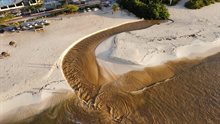Island Voices: interview with Ryan R. Peterson from Aruba
In the Caribbean part of the Kingdom, climate change is already being felt by people in the islands. It is getting warmer, periods of drought are increasing, and when it rains, it is intense with more rain falling in a shorter period of time. Tropical storms and hurricanes are also becoming more powerful. How should the islands adapt to climate changing conditions? What is happening to prepare the islands and islanders for the future? In the series of interviews ‘Island Voices’, residents from different islands and with different areas of expertise talk about how they view climate change and adaptation.
This time, we interview Ryan R. Peterson. Ryan is an Aruban native and holds the Chair of the National Climate Resilience Council (NCRC) of Aruba. He also holds a PhD in Economics and in his full-time capacity he is the Division Manager for Economic Policy at the Central Bank of Aruba. Ryan tells us why he thinks climate adaptation is important, how the National Climate Resilience Council (NCRC) wants to make Aruba more climate resilient, and about how the European Netherlands and Aruba can best work together.
Want to know more about climate adaptation in the Caribbean islands? Then check out the other pages on this knowledge portal about the Caribbean part of our kingdom.
Why are you concerned with climate adaptation in Aruba?
“Aruba has always relied on nature and climate as part of its development. So, when nature is endangered and climate effects are extreme, these have a direct impact on our lives. How we, as a small island society, cope and adapt to these changing conditions of climate and nature is a matter of existence and sustaining life on the island. For us, climate adaptation is not a ‘nice-to-have’, but a ‘must-have’.”
Which climate impacts is Aruba facing?
“Extreme weather events such as heat, drought, floods and sea level surges are increasing. Over the past years, Aruba experienced intensifying and extended heat events. This is having a significant impact on our elderly and people who work outside in, for instance, construction, agriculture, and tourism. How do we adapt our elderly care homes and occupational health and safety laws to this? Also, we have a major housing shortage on island. So for spatial urban planning we need to consider residential flood risks, but also the well-known impact of overheated urban areas. This then also raises questions on how we incorporate nature and the restoration of flora as an integrated part of urban adaptation to reduce the heat effects. Furthermore, coral bleaching has increased and our limited mangroves are in distress. And storm surges continue to erode our coastal areas and beaches. It is important to recognize that there are no quick and easy fixes to climate adaptation, especially as these climate impacts cut across different sectors and societal interests.”

How vulnerable is Aruba to extreme weather events?
“Aruba has always been exposed to changing patterns in climate. History teaches that we can be resourceful in finding ways to adapt. In terms of acute climate shocks, there’s a long-held belief that Aruba is outside of the hurricane belt, and by extension, invulnerable to extreme weather events. But when you look at our climate past, it is obvious that we are not untouchable. But more importantly, what we need to realize is that the slow-burn in climate is having a deep impact on our people and natural habitats. Our vulnerability is not only caused by surging temperatures and rising tides, but by underestimating the scars that this leaves in the lives of our people.”

On what scale should Aruba adapt?
“Climate change is a chronic stressor that leaves deep traces, especially for the most vulnerable people in our small community. This realization calls for equally deep adaptation. With this I mean not only the adaptation and reengineering of our coastal infrastructure, residential areas, or natural flood defenses, such as mangroves and reef islands, but also the adaptive capacity to revalue our beliefs and behaviors. That is why it is also important to strengthen our educational programs on climate resilience, not only in schools, but also in the community. Likewise, integrating climate adaptation strategies across public and private sector policies is essential. If we don’t adapt at this deeper level, we run the risk of postponing adaptation or taking wrong adaptation measures, such as expanding commercial areas in flood-risk zones, which subsequently affect residential areas and citizen safety.”
What conditions must Aruba meet to be climate resilient?
“I hold the Chair of the National Climate Resilience Council (NCRC) of Aruba. As the NCRC, we consider a small island state climate resilient if it is able to not only cope and adapt, but also transform and learn in the face of current and future climate changes. This means that we aspire and develop the capacity to lead a fulfilled life in harmony with nature. The lives and wellbeing of our people and nature are at stake.”
What do you think is needed for this?
“The NCRC was established in 2024 to create a framework of decisions and actions to strengthen our adaptation capacity and resilience to deal with climate change today, but also in the decades to come. This means that our framework needs to tackle existing climate impacts, but also anticipate and prepare for future climate impacts. And we need to design adaptation plans and programs. Obviously, this is not a short run. For this year, we set our objective on identifying Aruba’s climate risks and impacts. This way, we can create a complete view of the current and future risks of climate change. Based on these ongoing activities, in the next stage, we focus on assessing what adaptations options we have, and how we can implement our adaptations plans in a program.”

What are you committed to doing?
“As the national climate authority of Aruba, the NCRC provides a platform of different stakeholders across the public and private sector, as well as civil society and science. In essence, our work is dedicated to enhancing and fostering the wellbeing of society and nature. From developing and executing a national adaptation plan to exploring climate finance opportunities, building adaptation capabilities, strengthening climate education programs. The work is ongoing and will continue for decades to come. While there may be some guidelines, there is no standard script or manual for adaptation. We pave the path as we go, step by step, learning from past decisions, yet determined to move forward. We owe this to current and future generations.”
What do you expect from the European Netherlands?
“Considering our multiple climate risks, adaptation ambitions, and lack of financial, human, and information resources, the expectations from the European “ Netherlands could be extensive. But we also recognize, in the words of a Caribbean philosopher, that we cannot reach outward if we don’t stretch inward. So, the responsibility is ours to set our sail and assure that we have the best shipmates on board. Gratefully we are working together with different partners, involving Climate Adaptation Services (CAS), the International Panel for Deltas, Coastal Areas, and Islands (IPDC), and the Stimson Center for Environmental Security as we set sail on our journey.”
Final question: what do you want to pass on to future generations?
“In one word: Aruba. A home where our people thrive and nature triumphs.”

Ryan R. Peterson